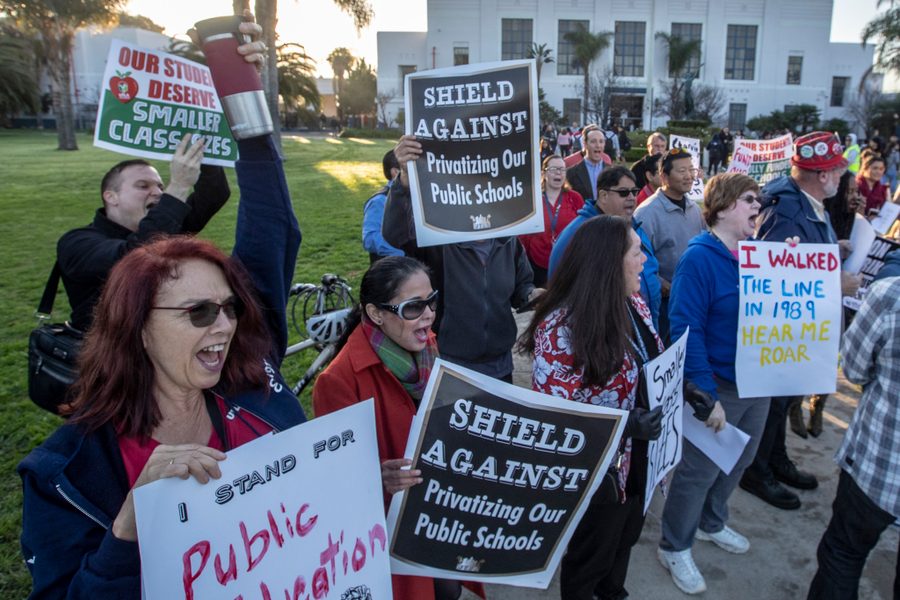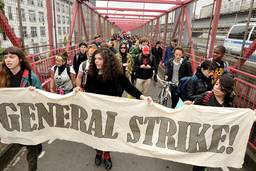
After nearly two years of bargaining, public-school teachers in Los Angeles have initiated a strike in protest of their district’s policies. Starting today, teachers are picketing outside of their workplaces, underscoring an inveterate lack of investment in public schools made worse by a pro-charter-school “austerity agenda.”
From April of 2017 to January of this year, United Teachers of Los Angeles (UTLA) — which represents more than 35,000 teachers, nurses, librarians and counselors in Los Angeles Unified School District (LAUSD) — had been in negotiations with the district, and eventually reached an impasse. The union’s proposals address grievances including preferential funding for charter schools, and such related problems as inflated class size, inadequate support for special and bilingual education, and excessive standardized testing.
The strike is the culmination of a protracted battle against the de facto privatization brought on by the growth of charter schools, which are publicly funded but privately operated — that is, independent of local school board regulations. In Los Angeles County, charter-school enrollment has risen 35.7 percent since 2012 to 2013, rendering the county, among dozens of others in California, one of the fastest-growing hubs of charter-school education.
In recent years, Los Angeles charter-school advocates have generated unprecedented financing: Pro-charter groups, for example, were responsible for more than two-thirds of the $14.3 million in campaign spending in a May, 2017, LAUSD school board election. That election saw pro-charter candidates clinch a majority and, the following year, appoint former investment banker and deputy mayor Austin Beutner as superintendent.
Much of this growth can be attributed to charters currying favor with Wall Street and Silicon Valley as grounds for tax breaks, real-estate investments, and business opportunities. In Los Angeles specifically, charter schools have become the pet projects of prominent billionaires, including Netflix chief Reed Hastings and real-estate developer and financier Eli Broad.
UTLA contends that the political climate of the school board has stripped traditional public schools of funding. A 2016 report commissioned by the union found that charters had siphoned $591 million from traditional public schools. The union also says that the district has $1.86 billion in “unrestricted” reserves, which UTLA claims can be used to fund LAUSD’s public schools. Beutner argues that the reserve funds exist, but are already being spent.
According to UTLA treasurer Alex Orozco, there’s no evidence the reserve funds have been spent, and the current distribution of funds has bred untenable student-to-teacher ratios. Orozco told In These Times that he visits schools with average class sizes in the 40s — a number that LAUSD’s own statistics for middle- and high-school classes confirm.
Beutner responded to these concerns via an article in the Los Angeles Times, proposing “to add teachers and reduce class size at 15 middle schools and 75 elementary schools in communities that have the highest needs.” UTLA holds that this falls short. “You can just feel the disrespect,” Orozco said. “The proposal that he put out addressed class size, which in the 16 months that we were in negotiations, not once did they address class size. But they addressed class size at the bare minimum, which is focusing on our neediest schools.”
Availability of essential personnel outside the classroom, including nurses, librarians, counselors and school psychologists, has also been compromised. For the 2014 to 2015 fiscal year, California ranked as the worst state in student-to-teacher librarian ratios. Meanwhile, California suffers a troubling shortage of school nurses. UTLA maintains that nearly 40 percent of LAUSD public schools have a nurse for only one day a week. According to Orozco, many schools are forced to pay out of pocket for a nurse.
This scarcity disproportionately affects students with disabilities and special needs, who may benefit from more regular visits. After appointments, nurses and school psychologists “are spending a lot of time doing paperwork,” says special-education teacher and UTLA rank-and-file member Allison Johnson. “So if they’re only there one day a week, then how much time are they actually getting to provide care for the students?”
Johnson’s concerns raise questions about the district’s support for students who depend on accommodations for disabilities, language barriers, and other needs. Traditional public schools are legally required to provide for these students. Charter schools, however, aren’t held to the same standards. A report from the Los Angeles Board of Education found that, as of 2014, the percentage of total LAUSD charter students with severe disabilities was less than one-third that of traditional district schools.
Another symptom of charterization, UTLA says, is an excess of standardized testing. According to UTLA president Alex Caputo-Pearl, the district requires up to 18 discretionary standardized tests—despite mounting nationwide criticism of standardized testing — in addition to those mandated by the federal and state governments. Orozco told In These Times that these tests are administered so frequently in order to generate school performance data, which can be leveraged into justifications for charter models.
Tests “make it very easy for the charters to come and privatize our schools based on this data that was collected by these exams that really are not necessary,” he said. “We want our teachers to be able to use their professional judgment and assess the kids in many other different ways.”
When contacted for comment, LAUSD referred In These Times to its website, which includes the following statement: “We hear our teachers and want to work with them. Los Angeles Unified and teachers agree — smaller class sizes, more teachers, counselors, nurses and librarians in schools would make our schools better. We know teachers deserve to be paid more and a working environment where kids can have the best possible education.”
In addition to its class-size reduction proposal, LAUSD has offered a six-percent pay raise to teachers, back pay for the 2017 to 2018 year, and no changes to their health benefits. In anticipation of a strike, the district has already hired 400 non-union substitute teachers for its more than 600,000 students.
Still, UTLA, frustrated by “20 months of fruitless bargaining and lies and manipulation,” as well as Beutner’s and other criticism in the media of the educators for their demands and decision to strike, feel this is far from enough. Echoing the concerns of many of her colleagues, Johnson argues that while a strike isn’t ideal, teachers have been left with no choice.
“It’s not about the raise,” she said. “People are mad. They want things to change. They want the profession to be respected and to have what we need to be able to function as educators.”







